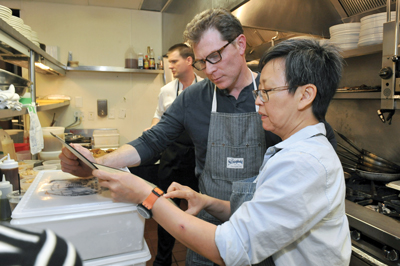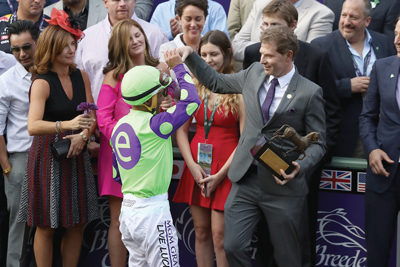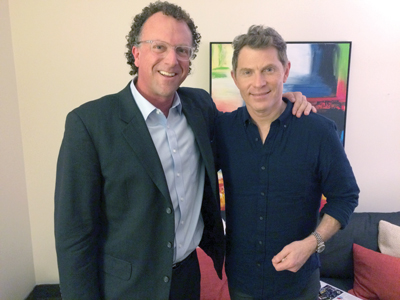“I’m just a real person that loves to cook.”
That’s what chef and restaurateur Bobby Flay tells me as he sits on a couch in his dressing room between shooting episodes of the Food Network’s competition series, “Beat Bobby Flay.” And that’s the authentic energy the 52-year-old exudes, both on television and in person.
I have been a fan of Flay’s ever since one of his first shows, “Grillin’ and Chillin.’” Since then, I’ve taken in a steady diet of his appearances on “Iron Chef” and signature shows, “Throwdown with Bobby Flay” and now, “Beat Bobby Flay.” As someone who grew up working in restaurants and around food, I’ve marveled at his talents. But Flay also comes across as genuine and kind; I admire his personal style and how he developed his brand (he’ll cringe when reading that). He also knows and understands sports, owns thoroughbred horses, has various interests in horse racing and appeared on ESPN’s Celebrity Fantasy Football League. So, on a brisk December morning, I walked down to the Herald Square area of Manhattan to visit Flay during a break of shooting and talk about life in and out of the kitchen.
 |
Photo: COURTESY OF BOBBY FLAY
|
The New York-born and raised Flay has a remarkable story of perseverance and resiliency. He loved sports growing up, far more than hitting the books. “I played a lot of basketball and baseball. I ran a lot of cross-country,” he says. School didn’t come naturally to him, despite his father’s example of success. “My father is very scholarly. He’s an attorney who got his master’s in art history in the 1970s. He speaks five different languages and is a person who is constantly formally educating himself. I was the complete opposite. I had no ability to learn in a traditional manner.” His inability to focus on academics led to dropping out of high school at 17. “I had gotten thrown out or dropped out of high school a couple of different times, up to the point where I said, ‘That’s enough.’ Even my father said, ‘That’s enough,’” he tells me. “I had no idea what I was doing. I was 17, so I wasn’t making any intelligent decisions. I needed a job. I needed to do something with my hands. I didn’t know that really at the time. But cooking in the kitchen at 17 made me excited about something for the first time.”
A high school dropout, Bobby Flay now operates 22 restaurants across the United States and has various interests in thoroughbred racing.
From pizza parlors to making salads in New York’s theater district, Flay stuck with it, going to culinary school before working his way through the city’s restaurant scene and bringing his signature Southwestern style to such restaurants as Mesa Grill and Bolo Bar & Restaurant. He now operates 22 restaurants across the United States and is widely recognized as being one of the first celebrity chefs to emerge in pop culture. But despite his numerous television and public appearances, Flay is firm that it’s all about the food and not about being a “celebrity brand.”
“Food is my entire world,” he says, taking a sip of coffee and leaning back on a couch. “It’s the four-letter word that my whole universe orbits around. Food is a very short and simple word, but food is the foundation of what I do. Not only because it’s helped me with success, but it’s the thing I love to do. It’s the common denominator of who I am. I like doing TV, but not that much. The Food Network has been a great family to me, I’ve been there for 20 years, but they know that it’s not the most important thing to me. I’m concentrating on the foundation of why I’m on the Food Network, not the flourishes that people think are important to television. Especially as time has changed, in any medium, we want real people. I’m just a real person that loves to cook. If I leave that part of me behind, I’m leaving myself incredibly vulnerable to failure.”
Flay cringes over the thought of the “Bobby Flay brand.” “The word ‘brand’ gets used a lot and I don’t know that I have a brand,” he says. “I have points of views. I think you could say that I might be an authority on certain subjects, but I don’t think I’m a brand. I think a brand gets sold a lot and I don’t get sold a lot. I try to take each opportunity, individually, and decide whether or not it’s a good idea to partake in it.” Fortunately for Flay, he’s largely made the right decisions and it’s a lesson he shares with younger chefs. “I always say to them, ‘It’s not what you decide to do that’s going to make your career, it’s what you decide not to do.’ I think being able to say ‘no’ with confidence is important.”
 |
Flay joins chefs Michael Symon and Carla Hall on the set of ABC’s weekday live show “The Chew.”
Photo by: GETTY IMAGES
|
Flay is quick to point out that not all of his decisions have worked out, and he understood failure would be part of the journey.
“Failure isn’t a bad thing, unless it’s a complete disaster,” he laughs. “Not everything I do works, and that’s OK. Everybody wants to be liked, and I get that everyone wonders, ‘Do they really like me?’ The way I measure that is through the success of my restaurant. Do people want to come and eat there? Do they like the food?
That’s the thing that’s important to me. I hadn’t opened a restaurant in New York in 10 years and then I opened Gato in 2014, and that process was just so crazy. The media has changed so dramatically from the last time I had opened a restaurant there. It used to be just The New York Times and New York Magazine and now, it’s all these blogs. If you add them all up, they don’t add up to The New York Times, but it’s a momentum thing.”
Sensing the new dynamic, Flay poured his entire energy into Gato. “I worked basically 16 hours a day to get Gato ready. I was cooking on the line, not expediting, but cooking on the line, next to all the cooks. I knew we were up against it. I knew that if I was going to get a good review across the board, and if the food needed to be an 8 to get there, I knew that I needed to deliver a 12. I was like, ‘They’re going to come after me because I’m a target.’ I was getting discounted before anyone even walked in, so I looked at everyone in the face and said, ‘Look, if you’re going to take me down, then you’re going to do it to my face because I’m going to be standing here, next to every single meal.’ I have to say, the press was great. Not just the press but the people seemed to really enjoy it. I think that they respected the fact that the food was good. To me, that’s what matters the most.”
In person, as on TV, Flay is pleasant and engaging — similar to the style he evokes when losing a barbecue throwdown or lasagna cookoff. I told him about a recent family gathering when I remarked how much I enjoyed Flay and my hardened, cynical brother shocked me by agreeing and saying, “He comes across as very gracious, winning or losing.” Flay thanked me for sharing the story and acknowledged that youth sports helped shape his attitude.
“I played a lot of team and individual sports, and I learned how to lose,” he said. “That’s a huge thing. I was taught that when we are beaten, to shake it off, shake hands, go home and work harder for the next time. I learned how to lose early on in my life, and I’m OK when I lose on the show. That said, you have to beat me. I’m not going to lay down for anybody. But when I get beaten fair and square, it makes me smile because that means that the show works.”
 |
Flay works with chef Patricia Yeo last year at the annual Harlem Eat Up! festival in New York.
Photo by: GETTY IMAGES
|
And he never feels robbed by the results. “In all the shows that I have done, I’ve never walked off after losing and saying, ‘That was bullshit, I should’ve won.’ Not once. I got beat every single time.”
Even in the pressure of a kitchen or under camera lights in a competition, the Irish-American Flay attempts to maintain his cool. “I have a temper only when I feel like people are doing things to me unfairly,” he said. “When I was a kid, we’d get into fights. I never started a fight, but once the fight started, I was in. I feel the same way about life. I don’t [mess] with anybody. I always keep to myself. Anything that is disappointing to me is on me and on my shoulders. With the restaurants and businesses, I blame myself. When somebody does something to me unfairly and with venom, that’s when I get upset.”
As a lunch of Middle Eastern staples is brought in, Flay uses fresh pita to mix up his hummus and falafel with tabouli and fattoush salad. Ever the competitor, Flay loves his sports and is well-versed across the board. He’s long had an interest in horse racing, as he owns several horses, including a share in 2016 Belmont Stakes winner Creator, and sits on the New York Racing Association Board of Directors.
“I’m in the business of horse racing,” he said between bites of food. “I breed a lot, I go to all the big sales and auctions, I buy and sell and race.”
A voracious reader of the Thoroughbred Daily News (“I read it every day”), he has progressive ideas about the sport that sometimes fall on deaf ears. He believes the sport can become relevant to a new generation of fans but admits “a lot has to change.”
“I’m one of the people looking for change in the business, but I think I’m in the minority. It’s a very old school business and, in general, people don’t like change. But when all the signals about the business are pointing down, you have to look at it. I’m really passionate about what I think it takes to make this better and there are some people who don’t really care about the future of it, they basically only care about what happens tomorrow, and you can’t think of it that way.”
He rolls off a litany of issues that need addressing, including race scheduling. “We have too much racing,” he believes. “I don’t think we should have racing on Thursdays in January in New York. For what?” He rolls on to improving facilities and the track experience, but says everything is secondary to the sport’s ethical abuses. “We need to get people who are cheating with drugs and other means out of the sport, and I mean in handcuffs,” he said emphatically, and grows increasingly upset by what he calls years of systemic abuse that hasn’t been cleaned up.
 |
Flay greets winning jockey Javier Castellano at the Breeders’ Cup.
Photo by: GETTY IMAGES
|
But he remains hopeful because of the sport’s beauty and history. “People have to experience a Breeders’ Cup in Santa Anita or any day at Saratoga. Keeneland is great, too,” he says with enthusiasm. “The experiences are getting better at certain tracks on certain days.”
Flay is a member of the Breeders’ Cup Board of Directors and he strongly advocates for the event to be at Santa Anita every year. “I know people like moving it around, and I understand that,” he
said. “With that said, Santa Anita’s got the weather, it’s got an incredible racetrack, it has Los Angeles, it has celebrities, it has media. What else you could possibly want?”
But he believes the Breeders’ Cup needs to be elevated as an entertainment spectacle to stand out. “We need A+++ musical entertainment. Not A+, but A+++. There are like five people in the world that I would want to bring in. Horse racing on its own is not a big enough draw; it needs to be part of an experience. My goal is to draw people who may not think they’re interested in horse racing, but they’d love to watch Beyoncé or Bruno Mars or Justin Timberlake sing three songs. If a couple of those people say, ‘Oh wait, there’s a horse race? This is really cool. I love it. This is spectacular, let’s go racing.’ That’s all I want, that’s it.”
He admires what Magna Entertainment has done around the Preakness Stakes and cites it as an example of a sterling turnaround in the sport. “The Preakness has done a really good job reinventing themselves. They have done a very good job of creating a very fun, upscale party. When I say upscale, I don’t mean exclusive, I mean better. The infield used to be a complete shit show. It was dangerous, people were drunk and there were fights. It’s so not necessary. Now, the infield is filled with great tents that have first-class food and beverage and different musical groups. It’s totally different.”
And, like many, he loves the simplicity and accessibility of the famed Saratoga. “I get to Saratoga around three to five times a summer. The greatest thing about Saratoga is the mornings. Get up early, go watch the horses work out, and I’ll talk to the trainers on the backstretch. Saratoga lets the people who aren’t horse owners get a little feel for behind the scenes, that’s what’s really special about it. The jockeys get off their horses after the race and walk back through the crowd back to their room, it’s amazing.”
When it comes to Flay’s bread and butter of culinary experiences, he sees them improving at sports venues but believes operators need to be careful in not trying to do too much. “It’s getting better,” he said confidentially. “They’re trying hard, and the smart approach is focusing on regional options. They’re utilizing their regions, you can get barbecue in Baltimore, amazing tacos at Dodgers Stadium, and the New York venues are utilizing a bunch of New York restaurants. People want better food, no matter where they are. But I don’t think we need to have vegan food, for example, at sporting events yet. They need to have vegetarian options like anywhere else, but venues should be careful about providing too many options.”
 |
Madkour and Flay
|
Ingredients for a ‘Throwdown’
As Flay finished up his Mediterranean lunch, I asked him what four things a feeble amateur wannabe cook should always have in their refrigerator or pantry. He laughed, “four is not enough.” After thinking, he said, “You need a couple of vinegars. You need canola oil to cook with, extra virgin olive oil not to cook with and it doesn’t touch heat. You need a couple of different mustards. Some honey. You also need a few things that aren’t going to be perishable like capers, olives, and a really good box of pasta and canned tomatoes. You also need a good chunk of Parmigiano-Reggiano in the refrigerator.”
OK, I’ll be ready for a Throwdown!
While an avid follower of sports, participation remains a key ingredient to Flay’s lifestyle. “I’m not an athlete anymore, because those times have passed,” he said, although you’d never know it by his lean build. “I had to hang up my basketball shoes about a decade ago. In my early 40s, I was still playing pretty competitive basketball and I just said, ‘This is just an ACL waiting to pop.’ I can’t afford to be on crutches for 12 weeks, so I just said, ‘That’s it.’ But I still compete; running is basically the last thing I can do.” He has run in three New York City Marathons (best time of 4:01:37) and with his 20-year old daughter studying abroad in London, Flay saw it as a good opportunity to run the London Marathon in April. He started his 17-week training program in early December and ran the morning I visited him. “I got up at 5, ran 8 miles on a treadmill, and came into work. I am tired,” he laughed. “I use running to stay in shape. I need goals. My ending-marathon-glory in my head is Rome, because I love Rome and Italy. I love the idea of running by the Colosseum.”
Flay’s lunch break is over, and he’ll soon be back in the studio to finish taping — he can knock out about three 30-minute episodes during one day of shooting. He thanks staff for bringing in lunch, and I ask if he has time for one more question: What does he look for in a hire — either for his kitchens, restaurants or shows.
“I look for two things,” he said immediately. “That they’re nice and that they’re ambitious, nothing else. They have to want it and they have to get along with others. Nothing else matters.”
Kindness and ambition — qualities that make sense because they are the qualities that have served Bobby Flay well throughout his career.
Abraham D. Madkour can be reached at amadkour@sportsbusinessjournal.com.











